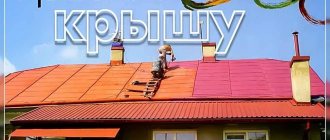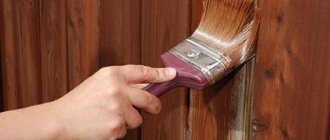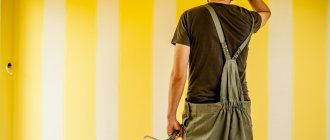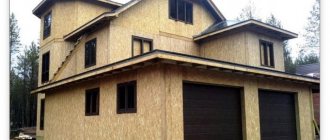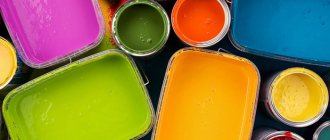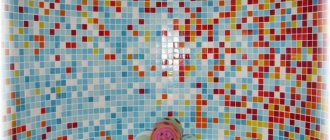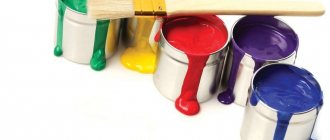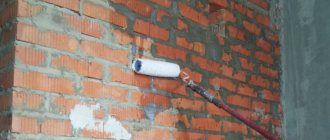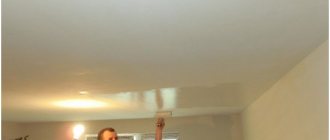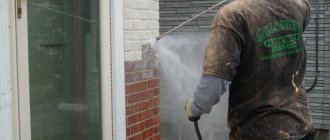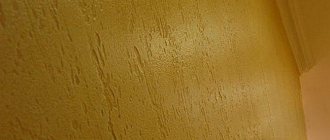Why should you paint slate roofs?
The first reason is indicated - plainness. It is difficult for slate to keep up with ondulin, corrugated sheets, metal tiles and other roofing coverings in terms of design. There is only one way out - to cover it with paint. This will not affect the cost of the roofing structure, because slate is the cheapest material. Having painted it, we cannot talk about high costs for paint per 1 m2.
In addition, the paint and varnish materials that are used to paint slate roofs today are not in short supply, their variety is quite wide, so there will be no problems with the choice. The dyeing process itself is simple. One worker is enough for a team of craftsmen to paint the roof of a large house.
The second reason is protective. Slate is a porous material. Over time, microcracks form on its surface. What this entails is probably not worth explaining. But we need to pay attention to this point. In winter, water penetrates into cracks where it freezes. Ice simply breaks the asbestos fibers, thus reducing the strength of the material itself.
The same applies to the process when mosses and lichens grow on slate. With their roots, they penetrate deeply into the body of the slate, widening and deepening the cracks.
Moss on slate is the cause of cracks Source ms.decorexpro.com
Therefore, painting is a protective layer that will not only become a barrier to water, but also an insurmountable barrier for plants. The film formed on slate from dried paint is very durable. In any case, she will be able to cope with the loads described above for several years. This means that a roof covered with slate will last longer.
The third reason is the harmfulness of asbestos. Several decades ago, propaganda against slate began in the West. It also moved to Russia, and was supported by manufacturers of more expensive building materials. Although it has long been proven that this is just propaganda to give other roofing materials the opportunity to be present and sold on the market. But if this aspect haunts you, then with the help of paint you will solve this problem.
So, let’s summarize why painted slate is better than unpainted slate:
- Increase the decorative effect of the roof structure.
- Using a certain type of paint, you can give slate a matte or glossy look .
- Make the surface smooth without pores or cracks.
- Do not allow mosses and lichens .
- Install protection against asbestos dust.
- Increase service life . Painted material will last 1.5 times longer.
Low decorative qualities of unpainted slate Source hi.decorexpro.com
Work methodology: reviews
If you decide to update your roof, it is recommended to read reviews about painting slate. Consumers say that it is best to use a spray bottle or a wide brush to apply antiseptic. It is important for the master to use protective equipment:
- glasses;
- gloves;
- respirator.
When choosing a primer, it is important to pay attention to formulations that contain ingredients that protect the surface from the formation of moss and mold. According to buyers, it is better to apply the primer in several layers. When painting slate yourself, it is best to purchase a primer from the same manufacturer as the decorative material that will be used at the final stage of upgrading the roof.
It is best to start work early in the morning when the weather is not too hot. The ideal humidity level for this is considered to be between 40 and 60%. This combination with a temperature of 20 °C is quite rare, so it is recommended to follow the instructions.
It is important to pay attention to the processing of ends, hard-to-reach areas and corners. Approximately 60% of the total paint volume will be used for the base coat.
Types of paints for slate
A roof, even one covered with paint, requires special treatment. It is subject to all known natural stresses, so the choice of paint must be approached with special care. That is, it must withstand sunlight, changes in humidity and temperature, and mechanical stress. At the same time, it should adhere well to asbestos-cement slate.
That is, you cannot paint slate with whatever paint comes to hand first. Here is a list of suitable colors:
- acrylic;
- silicone;
- alkyd;
- enamel called “Liquid Plastic”.
Let's look at each variety separately and determine their technical characteristics, as well as their pros and cons.
Acrylic paints
This is the most extensive line of paint and varnish products with intense color and varying degrees of gloss (from highly glossy to highly matte). This category of coatings is divided into two groups:
- water-based , also known as water-dispersed;
- based on organic solvents .
Group No. 1
Composition: latexes, also known as acrylic copolymers, pure water, pigments and various additives that improve the quality of paint (antifreeze, biocides, etc.). It should be noted that the percentage of water in the paint is no more than 15%. It functions as a diluent and solvent.
Water-dispersed acrylic paint Source kbumb.ru
Here are the advantages of acrylic water dispersion material:
- it is an environmentally friendly material that, under the influence of natural loads, does not emit harmful substances into the atmosphere;
- high adhesion to any building materials, including slate;
- high degree of hiding power , in the range of 200-300 ml/m2;
- ease of application;
- resistance to precipitation;
- it is not toxic material;
- high fire resistance because the base is water;
- no need to add chemical solvents;
- dries within 1-2 hours;
- the paint layer increases the frost resistance of slate;
- increases the waterproofing properties of roofing material;
- service life – 5 years.
In the group of water-dispersed acrylic paints there is a subgroup called “rubber”. These are all the same components, only the structure of the material is thick mastic. It is applied to the roof in a thin layer, which, after drying, forms an elastic flexible film, very similar to rubber. Hence, in principle, the name.
Rubber paint for slate roofing Source inni.info
See also: Catalog of companies that specialize in paints and varnishes.
The film is not only elastic, but also very durable. At the same time, it covers cracks up to 1 mm wide well, preventing them from expanding later. Mastic has high adhesion to porous surfaces. And it is one hundred percent waterproofing coating. It is represented on the market in a fairly wide range. It is available in cans and buckets labeled “Rubber Paint.”
Group No. 2
Acrylic paint for this type of slate roof is not diluted with water. For this purpose, solvents of organic origin are used, most often white spirit is used. There are also matte and glossy paints, which differ from each other in the amount of acrylic resin added to the composition. The higher its percentage, the higher the gloss of the material.
How does this variety differ from water-dispersed:
- the colorful film applied to slate is stronger ;
- higher water-repellent characteristics;
- increased elasticity of the coating;
- Keeps for a long time .
The disadvantages include a pungent odor that gradually disappears, slightly higher consumption - 250-350 ml/m2, longer drying time - within 10-24 hours. Here you can add not the widest range presented on the modern market.
Acrylic paint for slate using organic solvents Source blues-dev.ru
Silicone paints
Silicone paints consist of pigments and silicone binders, which give the paint and varnish material special strength and elasticity. Therefore, silicone-based paints are rightfully considered reliable and durable coatings, and not only for slate. Only they can close cracks up to 2 mm wide.
So, what are the advantages of this type of paintwork:
- increased strength of the applied layer;
- maximum possible elasticity ;
- additives are added to the paint to prevent the formation of colonies of harmful microorganisms on roofs;
- high waterproofing qualities;
- high dirt-repellent properties;
- silicone paints can be applied to slate without first priming the latter;
- high fire safety ;
- it is non-toxic material;
- service life within 10-15 years.
The only negative that should be noted is the high price compared to other types.
Silicone slate roofing paint Source spectr-lkm.ru
Video description
The video shows the process of painting slate:
Polymer paints
“Liquid plastic” got its name for a reason. It consists of suspensions of various polymers. This can be PVC (polyvinyl chloride), polystyrene or polyurethane. Each of them is the main paint and varnish product. This also includes pigments, additives that improve the quality of paint, and solvent. It turns out that after applying the paint layer, the solvent evaporates from it, and the polymer dries and hardens, forming a thin layer of plastic on the slate roof. In this case, the surface may be either glossy or matte.
Advantages of this material:
- absolute moisture resistance ;
- dries within half an hour;
- 100% environmentally friendly ;
- the material is inert to chemistry;
- plastic is a non-flammable ;
- The paint can be applied without prior priming ;
- does not lose its design qualities under the influence of sunlight, precipitation and wind;
- the highest frost resistance , paint can be applied to slate even at a temperature of -10C;
- service life – 10-15 years.
So, we examined those types of paint and varnish products that answer the question posed by the topic of the article - how to paint slate on the roof. Now let's move on to the section on how to properly paint a slate roof.
Paint “Liquid plastic” Source kbumb.ru
Surface preparation
If you need to paint old slate that has been lying on the roof for some time, then this can only be done after preliminary preparation. First, the roof should be cleaned of dirt, fungus, moss and all cracks in it should be repaired. Small cracks are “patched” using fabric, pre-impregnated with waterproof glue. Large cracks are filled with mastic from a mixture of dissolved asbestos with PVA glue and cement. If there are a large number of cracks and chips on the roof, painting it without preliminary repairs will be pointless. In such a situation, it is best to first replace the roof and, only after that, paint. In this case, it will be enough to change only the failed sheets. Slate cleaning can be done manually or using a sink that produces a jet with strong pressure. Cleaning the roof manually is difficult. Even using a brush for these purposes may not give the desired result. To simplify the process, the brush can be replaced with an electric drill with a special attachment, however, in this case there is a risk of damaging the material itself. It is easier to clean the roof using a washer; the main thing is to choose the right water pressure, which will remove dirt and not damage the slate. In this case, it is better to set the pressure to 200-250 atmospheres. After cleaning, the roof is disinfected with an antiseptic. Before painting cleaned slate, it should be primed. The primer is applied at a temperature not lower than 5 and not higher than 30 degrees. Then, the composition is allowed to dry for 12 hours and painting begins.
Washing slate before painting
Primer for slate
Slate painting technology
It should be immediately noted that even the most expensive and high-quality paint chosen for the design of slate laid on the roof is not a guarantee that the applied coating will withstand its allotted service life. The most important point is to carry out the painting process correctly. It is divided into several stages, the sequence of which must be strictly followed.
Stage No. 1
First of all, the slate laid on the roof must be prepared. That is, the slate roof is being cleaned. This is done in three ways:
- Mechanical . To do this, use scrapers, brooms, brooms, brushes and other identical hand tools and devices. With their help, dust, dirt, debris, and small vegetation are removed from the slate surface.
- Hydraulic . To do this, use a stream of water under high pressure. You will need a long hose, a nozzle, a pump and a container of water (you can connect the pump to the water supply).
- Combined . They combine the two previous methods, which is more effective, especially when old slate coverings are prepared for painting.
How to clean a roof with water pressure Source blues-dev.ru
Stage No. 2
At this stage, the roofing material is primed. Usually it is selected according to the technical characteristics of the paint. It is better if the primer and paint are from the same manufacturer. As mentioned above, some slate paints can be installed without prior priming.
If a primer is necessary, it is applied to the slate with brushes, rollers or a spray gun. The latter option is simpler and more convenient to apply, and also more economical. It is better to apply the primer in two layers, ensuring that the first one dries well before applying the second.
Applying primer with a spray gun Source blues-dev.ru
Stage No. 3
This process is no different from priming. It is carried out with the same tools. The material is applied in two layers, the first must be dried before applying the second. The first layer is considered the base layer. With its help, all irregularities and defects in the roofing material are covered. Therefore, it is very important to paint the joints, corners, slate ends, as well as ridge and gable elements.
The second layer is already the finishing (painting) layer. It is with its help that the color design of the roofing structure is created. It is this layer that creates a bright, uniform color; there should be no streaks or smudges left on it.
